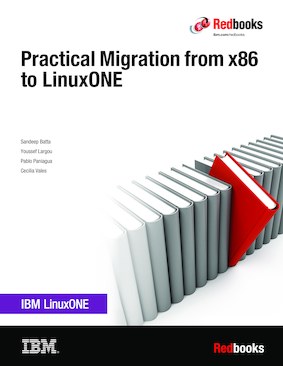
Published on 25 September 2024
Share this page:
ISBN-10: 0738461725
ISBN-13: 9780738461724
IBM Form #: SG24-8377-02
Authors: Lydia Parziale, Sandeep Batta, Youssef Largou, Pablo Paniagua and Cecilia Vales
Abstract
IBM LinuxONE is a portfolio of hardware, software, and solutions for an enterprise-grade Linux environment. It is designed to run more transactions faster and with more security and reliability, specifically for the open-source community. It fully embraces open-source-based technology.
The following LinuxONE servers are now available: IBM LinuxONE 4 LA1, IBM LinuxONE 4 LA2, IBM LinuxONE 4 AGL, and IBM LinuxONE Express.
Aside from still running SUSE Linux Enterprise Server and Red Hat Enterprise Linux (RHEL) Servers, LinuxONE runs Ubuntu, which is popular on x86 hardware.
Ubuntu, which runs the cloud, smartphones, a computer that can remote control a planetary rover for NASA, many market-leading companies, and the Internet of Things, is now available on IBM LinuxONE servers. Together, these two technology communities deliver the perfect environment for cloud and DevOps. Ubuntu 16.04 on LinuxONE offers developers, enterprises, and Cloud Service Providers a scalable and secure platform for next-generation applications that include OpenStack, Kernel-based Virtual Machine (KVM), Docker, and JuJu.
The following reasons are why you would want to optimize your servers through virtualization by using LinuxONE:
- Too many distributed physical servers with low utilization
- A lengthy provisioning process that delays the implementation of new applications
- Limitations in data center power and floor space
- High total cost of ownership (TCO)
- Difficulty allocating processing power for a dynamic environment
This IBM Redbooks® publication provides a technical planning reference for IT organizations that are considering migrating from their x86 distributed servers to LinuxONE. This book walks you through some of the important considerations and planning issues that you might encounter during a migration project. Within the context of a pre-existing UNIX based or x86 environment, it presents an end-to-end view of the technical challenges and methods necessary to complete a successful migration to LinuxONE.
Table of Contents
Part 1. Decision-making
Chapter 1. Benefits of migrating workloads to IBM LinuxONE
Chapter 2. Analyzing and understanding
Chapter 3. Virtualization concepts
Part 2. Migration
Chapter 4. Migration process
Chapter 5. Migration analysis
Chapter 6. Hands-on migration
Chapter 7. Post migration considerations
Part 3. Deployment
Chapter 8. Deployment of workloads
Part 4. Appendix
Appendix A. Additional use case scenarios